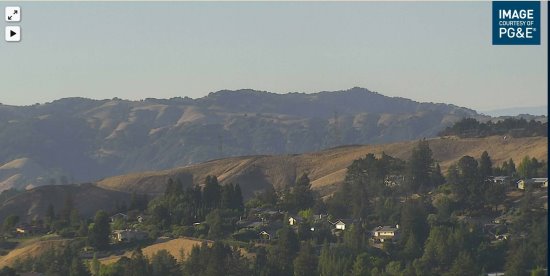 | | | View from Moraga's Alta Mesa camera Photo provided | | | | | | The concept of cameras located on mountain peaks, taking real-time videos of local topography in order to alert fire crews to a potential disaster, sounds like an idea that should have been invented ages ago. In fact, the ALERTWildfire cameras have only been around since 2013, but better late than never as each new fire season approaches with ever increasing drought conditions.
 Graham Kent, ALERTWildfire system co-creator and director of the Nevada Seismological Laboratory at the University of Nevada, Reno, explained the key advantages to the cameras. "They help to reduce response time to wildfires; agencies can scale their resources up or down within seconds of confirmation or discovery; agencies are able to follow fire behavior in real-time; the cameras provide critical info to first responders and public during explosive phases, where timely evacuations can save lives; and the cameras provide a watchful eye to reduce the likelihood of re-ignition after containment."
Graham Kent, ALERTWildfire system co-creator and director of the Nevada Seismological Laboratory at the University of Nevada, Reno, explained the key advantages to the cameras. "They help to reduce response time to wildfires; agencies can scale their resources up or down within seconds of confirmation or discovery; agencies are able to follow fire behavior in real-time; the cameras provide critical info to first responders and public during explosive phases, where timely evacuations can save lives; and the cameras provide a watchful eye to reduce the likelihood of re-ignition after containment."
 The camera's pilot program began with ALERTTahoe and the deployment of the first Pan-Tilt-Zoom cameras and microwave networks. The success of the program grew eastward into northern Nevada. As word spread of the successful summers between 2014-16, new contracts came in from Oregon, Washington, Idaho, Utah and California where 300 new cameras were installed in the year following the 2018 Camp Fire. An additional 300 cameras were installed in the Western United States during the disastrous 2020 fire season. ALERTWildfire projects over 175 more cameras for installation across five states this year. Between 2016-2020, the cameras have provided critical information for over 1,500 fires. ALERTWildfire hopes to install 1,000 cameras in California alone by 2022.
The camera's pilot program began with ALERTTahoe and the deployment of the first Pan-Tilt-Zoom cameras and microwave networks. The success of the program grew eastward into northern Nevada. As word spread of the successful summers between 2014-16, new contracts came in from Oregon, Washington, Idaho, Utah and California where 300 new cameras were installed in the year following the 2018 Camp Fire. An additional 300 cameras were installed in the Western United States during the disastrous 2020 fire season. ALERTWildfire projects over 175 more cameras for installation across five states this year. Between 2016-2020, the cameras have provided critical information for over 1,500 fires. ALERTWildfire hopes to install 1,000 cameras in California alone by 2022.
 First responders aren't the only agencies taking advantage of the extra pair of eyes on the horizon. Utility companies, such as Pacific Gas & Electric Co., have installed the high-definition fire-watching cameras in locations where extreme fire risks pose a threat. By doing so, according to its website, PG&E is hoping to reduce the size and number of Public Safety Power Shutoffs. At the end of this year, they will have installed 340 cameras throughout Northern and Central California, with a projection of 600 total camera installations by the end of 2022.
First responders aren't the only agencies taking advantage of the extra pair of eyes on the horizon. Utility companies, such as Pacific Gas & Electric Co., have installed the high-definition fire-watching cameras in locations where extreme fire risks pose a threat. By doing so, according to its website, PG&E is hoping to reduce the size and number of Public Safety Power Shutoffs. At the end of this year, they will have installed 340 cameras throughout Northern and Central California, with a projection of 600 total camera installations by the end of 2022.
 Some of the camera locations covering the Lamorinda area include: Briones Tabletop; Highway 24 and Lucas Drive both in Lafayette; Alta Mesa and Mulholland Ridge both in Moraga; and the areas near Vollmer Peak by Orinda. The cameras are capable of zooming in between 10 to 40 miles in order to verify directions given from a 911 call. This feature helps to either pinpoint a fire or redirect firefighters to a corrected location.
Some of the camera locations covering the Lamorinda area include: Briones Tabletop; Highway 24 and Lucas Drive both in Lafayette; Alta Mesa and Mulholland Ridge both in Moraga; and the areas near Vollmer Peak by Orinda. The cameras are capable of zooming in between 10 to 40 miles in order to verify directions given from a 911 call. This feature helps to either pinpoint a fire or redirect firefighters to a corrected location.
 ALERTWildfire also is available for viewing by the public, and the company boasts that people have begun having watch parties where a group of volunteers come together to try and detect early fires in their area. When told about this activity, Moraga-Orinda Fire District Captain Jacob Airola stated before the holiday weekend, "We're [MOFD] going to have an 'in-person' watch party during the Fourth of July on Mulholland Ridge!"
ALERTWildfire also is available for viewing by the public, and the company boasts that people have begun having watch parties where a group of volunteers come together to try and detect early fires in their area. When told about this activity, Moraga-Orinda Fire District Captain Jacob Airola stated before the holiday weekend, "We're [MOFD] going to have an 'in-person' watch party during the Fourth of July on Mulholland Ridge!"
 For more information visit?www.alertwildfire.org.
For more information visit?www.alertwildfire.org. |
